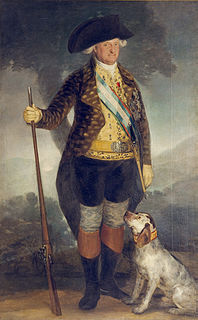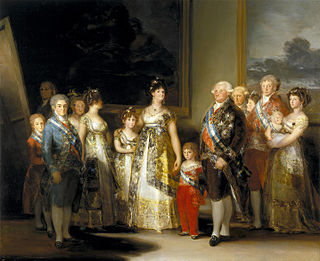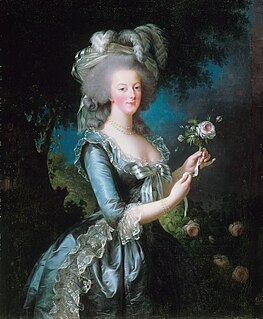 W
WCharles IV in his Hunting Clothes is an oil on canvas painting of 1799 by the Spanish artist Francisco Goya, the second of his two portraits of King Charles IV of Spain. Goya had earlier been court painter to Charles III, who was widely viewed as the more astute political operator of the pair. While not lacking intelligence, Carlos IV is broadly seen as an idler compared to his father; ultimately he was outmaneuvered by Napoleon at a time when he was more interested in sport and hunting than affairs of state.
 W
WCharles IV of Spain and His Family is an oil-on-canvas painting by the Spanish artist Francisco Goya. He began work on the painting in 1800, shortly after he became First Chamber Painter to the royal family, and completed it in the summer of 1801.
 W
WPortrait of Queen Christina of Denmark is late work of the Italian Renaissance master Titian, painted in 1555–1556 as an oil on canvas and now housed in the National Museum of Serbia of Belgrade, Serbia. It depicts Christina of Denmark. This painting was part of collection of Mary of Hungary (1505–1558) already in 1556. Before the World War II was part of Contini Bonacossi Collection.
 W
WThe Plimpton Sieve Portrait of Queen Elizabeth I is an oil painting by English painter George Gower dated 1579, and now in the collection of the Folger Shakespeare Library in Washington, D.C. It is one of three near-identical portraits of Elizabeth I by Gower that represent the queen holding a symbolic sieve. It was acquired by George Arthur Plimpton in 1930, hence the name. His son, Francis T. P. Plimpton, willed it to the Folger.
 W
WThe Portrait of Frederick II of Prussia is a portrait of Frederick II of Prussia by the German-Danish painter Johann Georg Ziesenis. In 1913 the painter Jean Lulvès claimed it was the only painting for which Frederick sat during his lifetime - however, this is now doubted.
 W
WKing Gustav III of Sweden and His Brothers is an oil painting by the Swedish portrait painter Alexander Roslin showing Gustav with his two brothers, Prince Frederick Adolf and Prince Charles, later Charles XIII of Sweden. Frederick is standing, Gustav is sitting to the left, and Charles is to the right. The painting is in the collection of the Swedish National Museum.
 W
WPortrait of Louis XIV in Coronation Robes was painted in 1701 by the French painter Hyacinthe Rigaud after being commissioned by the king who wanted to satisfy the desire of his grandson, Philip V, for a portrait of him. Louis XIV kept it hanging at Versailles. This portrait has become the "official portrait" of Louis XIV.
 W
WMarie Antoinette and Her Children, also known as Marie Antoinette of Lorraine-Habsburg, Queen of France, and Her Children is an oil painting by the French artist Élisabeth Vigée Le Brun, painted in 1787, and currently displayed at the Palace of Versailles. Its dimensions are 275 by 216.5 cm.
 W
WMarie Antoinette with a Rose, also known as Marie-Antoinette with the Rose is an oil painting by the French artist Élisabeth Vigée Le Brun. It was painted in 1783, and is in the collection of the Palace of Versailles.
 W
WThe Pelican Portrait is an oil painting of Elizabeth I of England on a wood panel, named for the pelican pendant shown on Elizabeth's breast. It is generally attributed to Nicholas Hilliard, on the basis of a scientific study and similarities to his other work.
 W
WThe Equestrian Portrait of Philip III is a portrait of Philip III of Spain on horseback by Diego Velázquez. It was painted in 1634/35, some years after the subject's death, as part of a series of paintings of the royal family. Intended to be displayed in the Hall of Realms, originally a wing of the Buen Retiro Palace in Madrid, it is now in the Prado Museum.
 W
WPhilip II in Armour is a portrait of Philip II of Spain by Titian, painted in 1551 when they were both in Augsburg.
 W
WThe Equestrian Portrait of Philip IV was a portrait of Philip IV of Spain on horseback, painted by Diego Velázquez in 1635-36 as part of a series of equestrian portraits for the Hall of Realms, originally a wing of the Buen Retiro Palace in Madrid.
 W
WThe Portrait of Mehmet II is a painting by the Venetian artist Gentile Bellini, depicting the Ottoman sultan, Mehmet the Conqueror. It was painted in 1480 while Bellini was in Constantinople on a diplomatic mission. This painting is a record of the significant economic and diplomatic ties that existed between Venice and the Ottoman Empire in the 15th century. Before this painting, the Ottomans had recently conquered Constantinople. This put the Venetian Republic in a situation where they had no choice but to accept a peace treaty from Mehmet the conqueror in 1479. Venice was actively tied with Constantinople through commercial links because of their close proximity to the Mediterranean sea. The importation of raw silk, cotton, illuminated manuscripts, inlaid metalwork, and spices would have ground to a halt without this peace treaty. After a peace treaty is brokered between the Venetian Republic and the Ottoman Empire, the Sultan Mehmet II decided that he would like an Italian painter to be in residence at his court and paint for him; this task was placed upon Gentile Bellini.
 W
WPortrait of Napoleon III, or initially called in French Portrait de S. M. l'Empereur is an oil painting of 1861 by the French painter Jean-Hippolyte Flandrin, depicting France's Emperor Napoleon III standing in his Grand Cabinet. At its first presentation in the Universal Exhibition in 1862, the painting attracted praise for its true-to-life representation of Napoleon III.
 W
WThe "Streatham" portrait is an oil painting on panel from the 1590s believed to be a later copy of a woodcut of the English noblewoman Lady Jane Grey from 1580. It shows a three-quarter-length depiction of a young woman in Tudor-period dress holding a prayer book, with the faded inscription "Lady Jayne" or "Lady Iayne" in the upper-left corner. It is in poor condition and damaged, as if it has been attacked. As of January 2015 the portrait is in Room 3 of the National Portrait Gallery in London.
 W
W